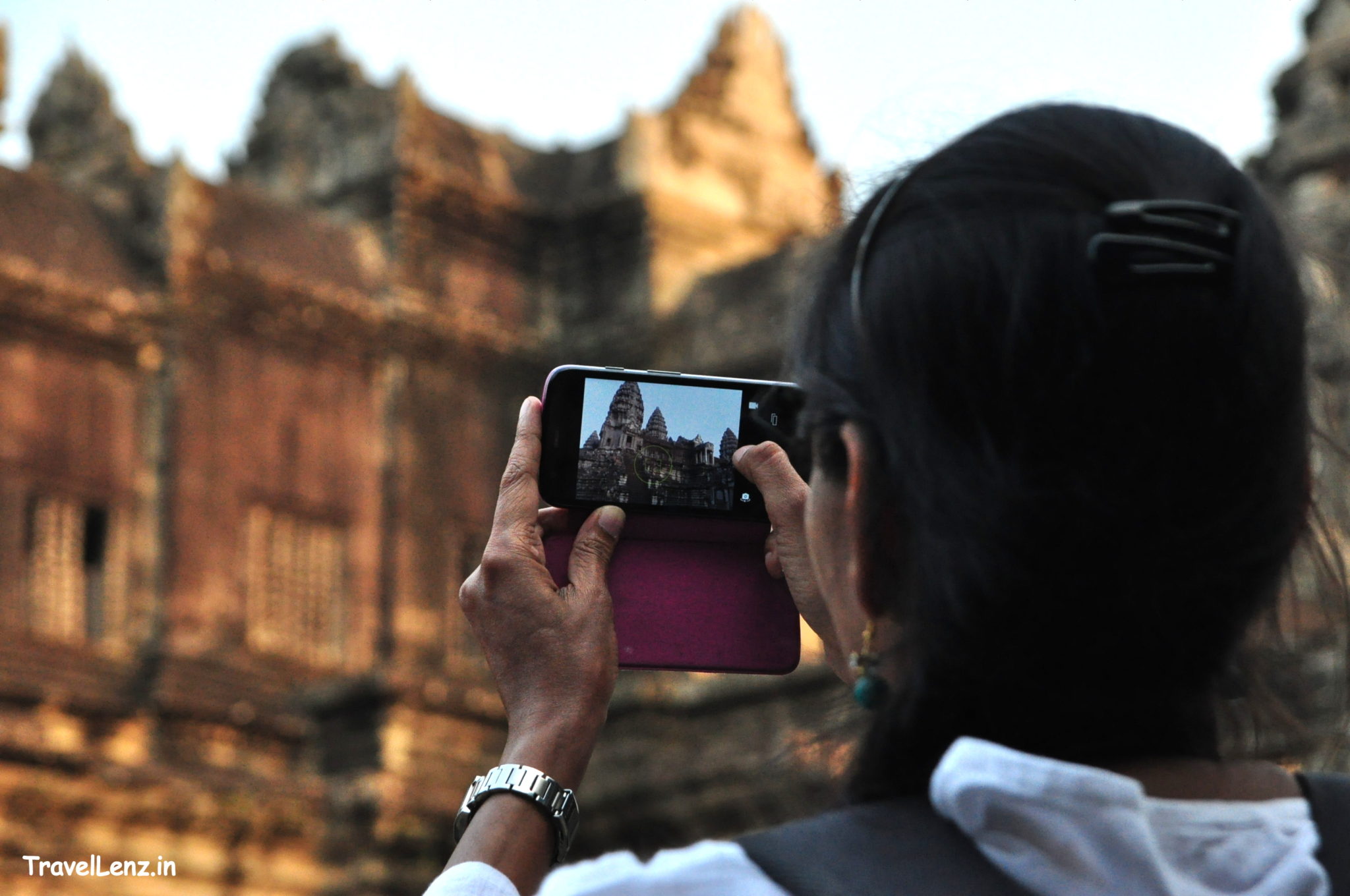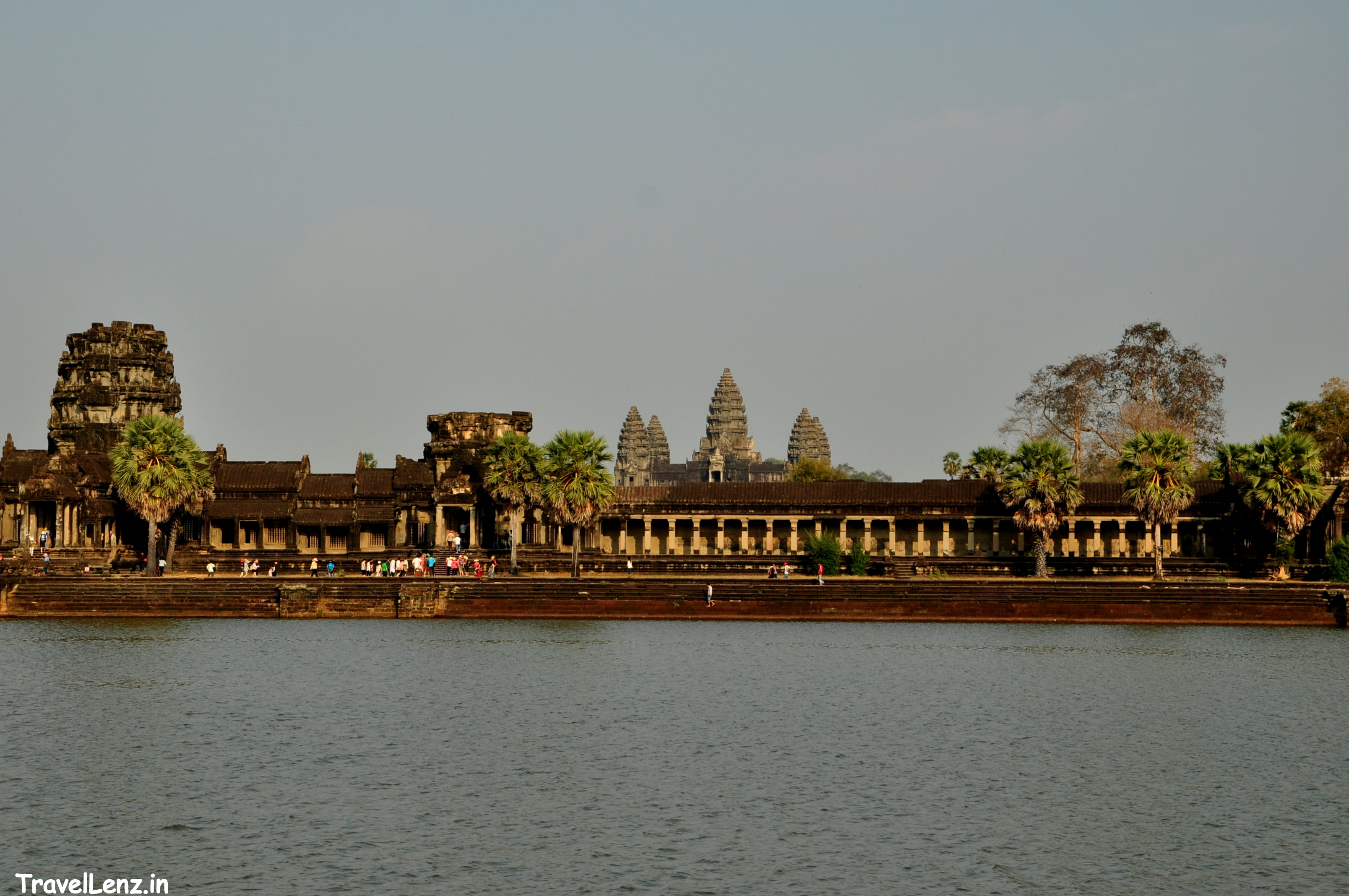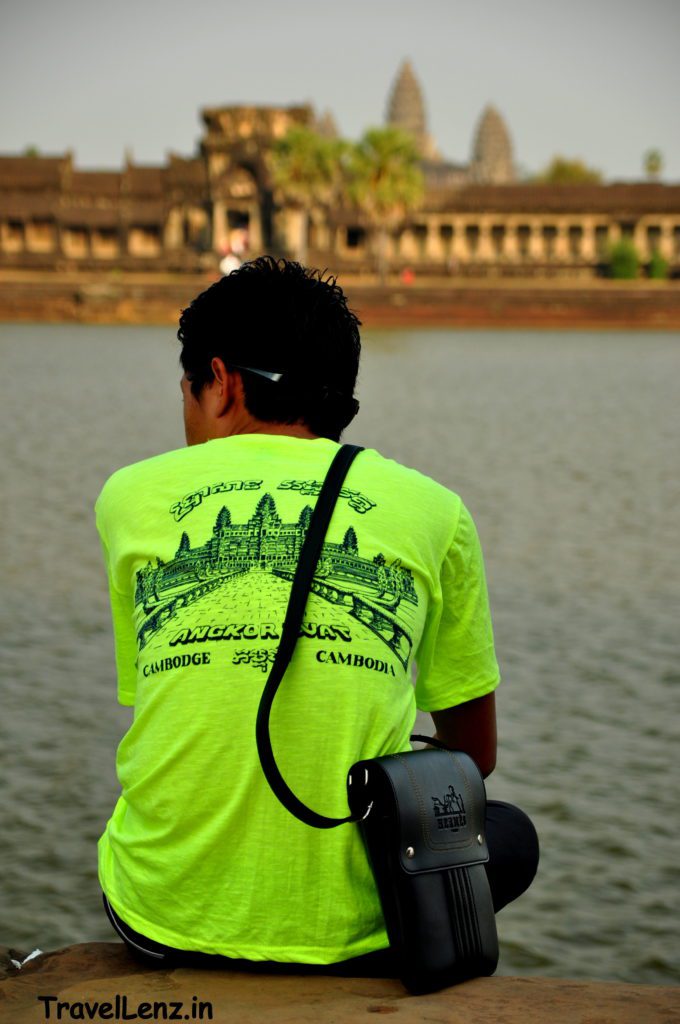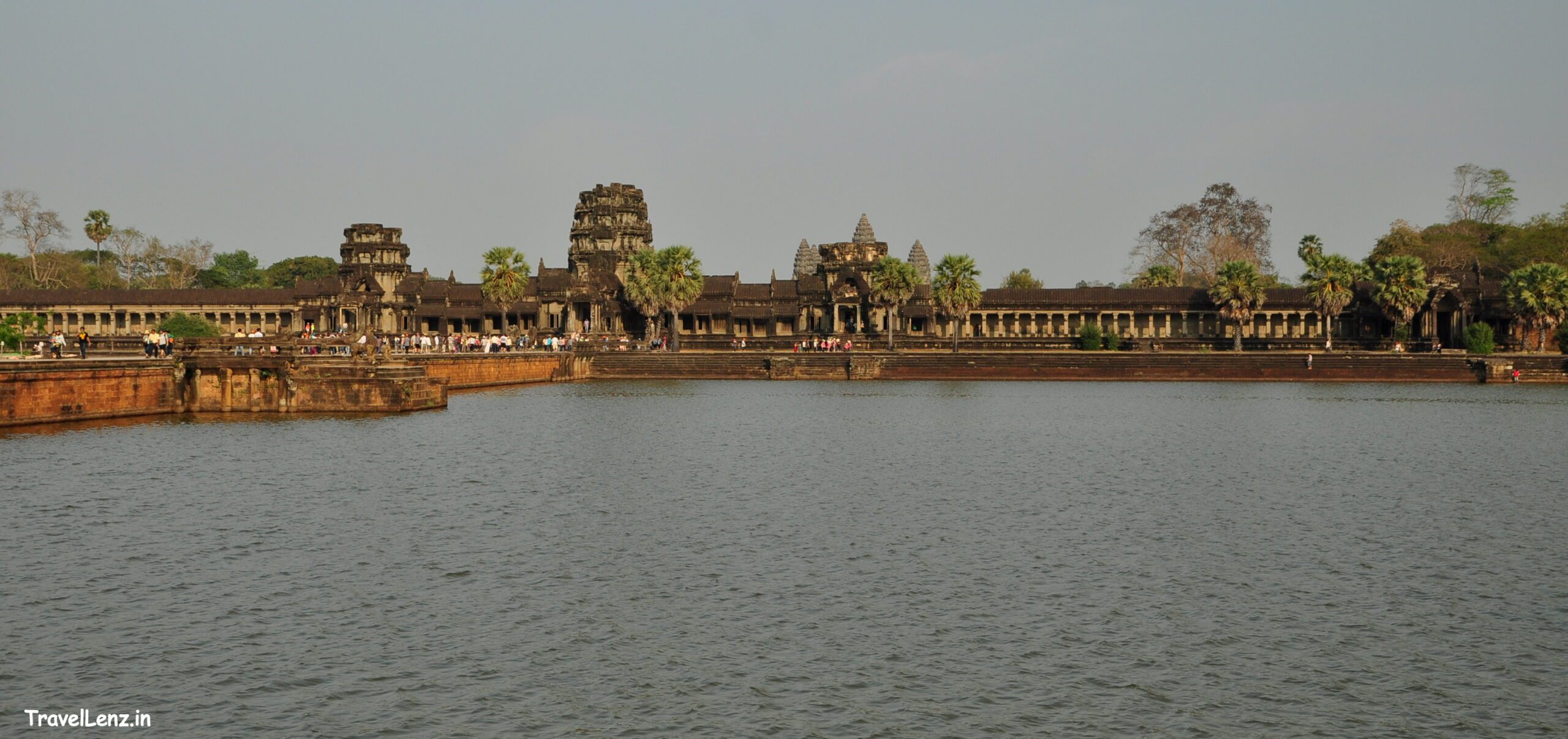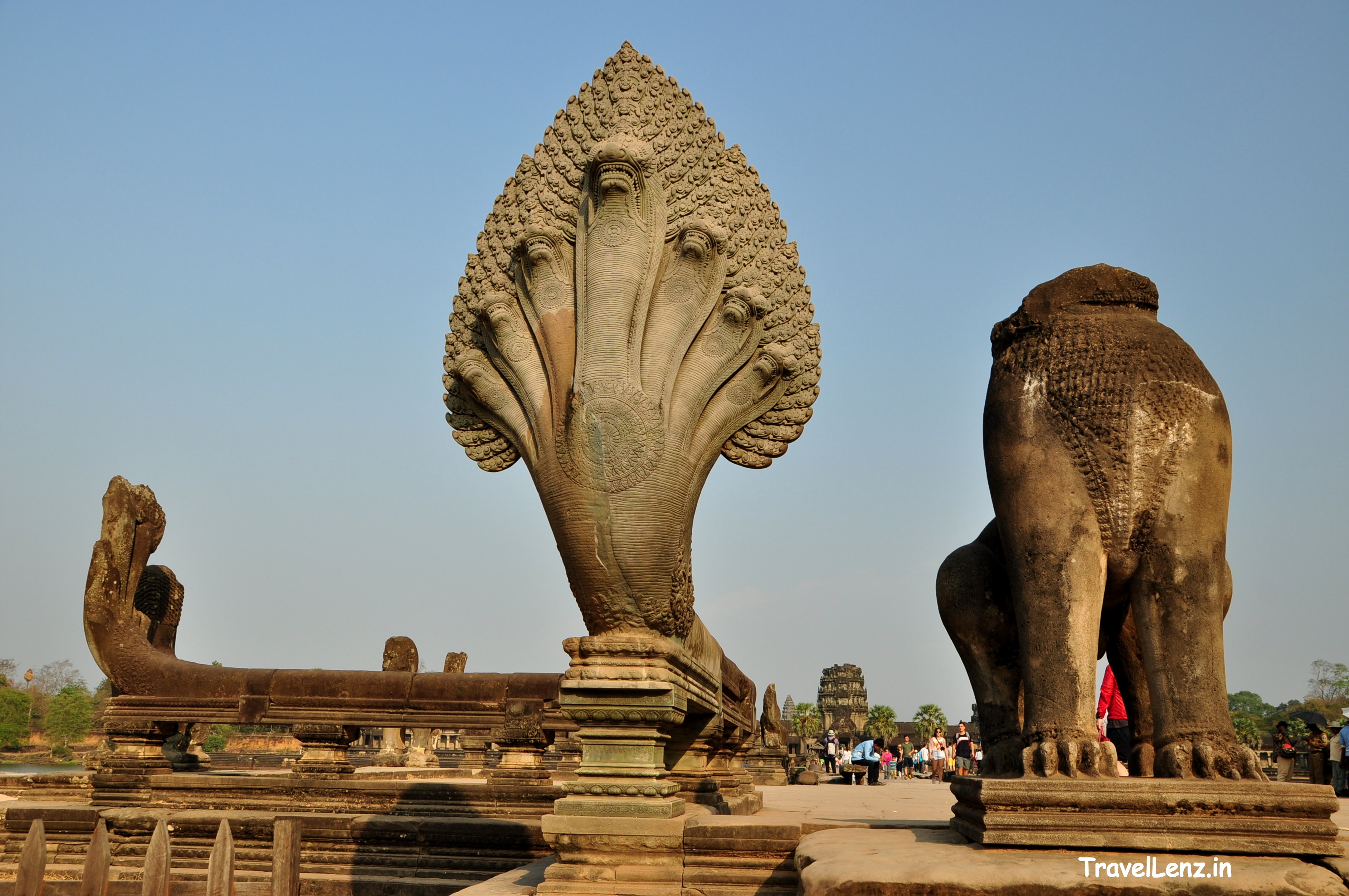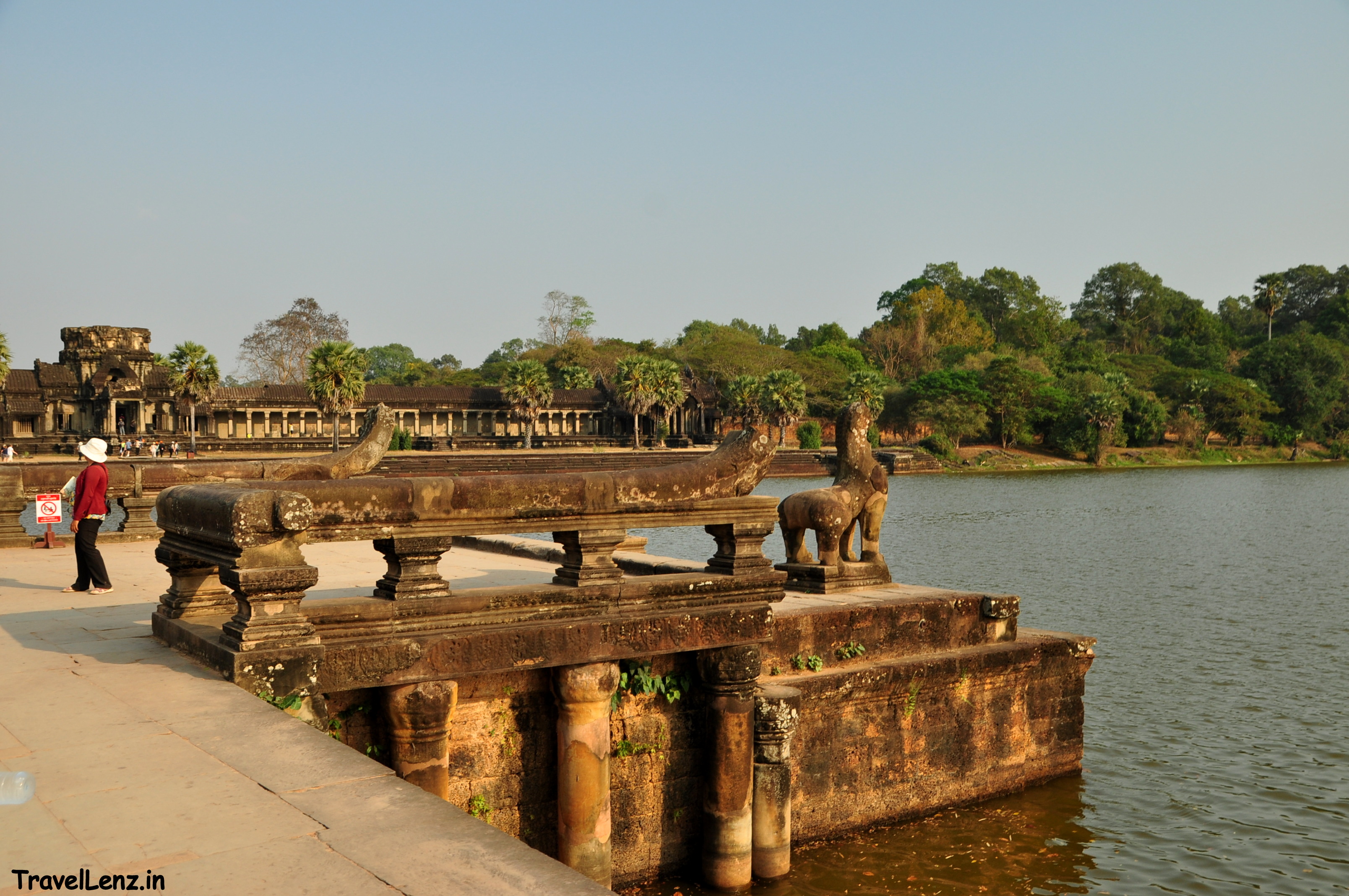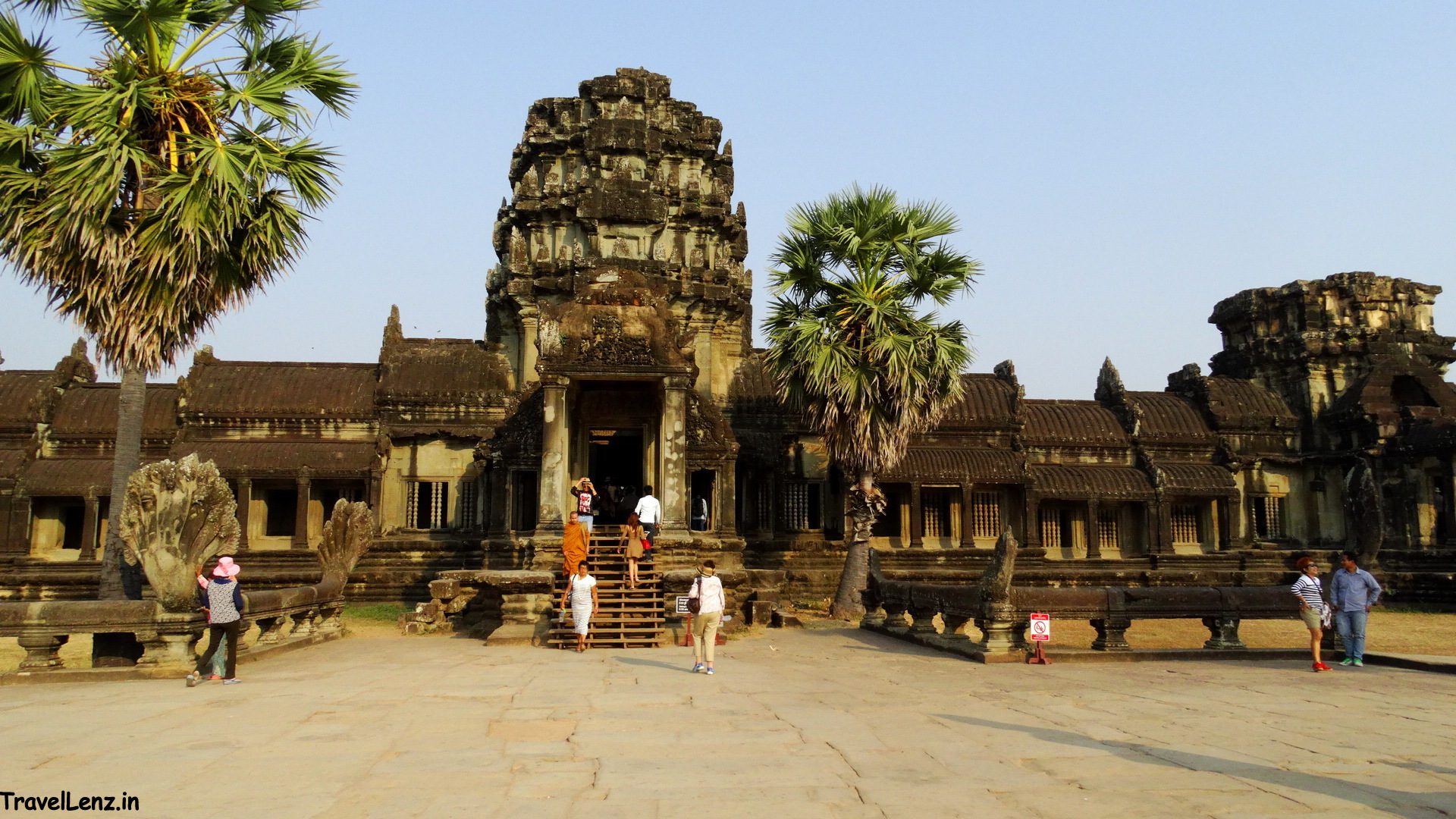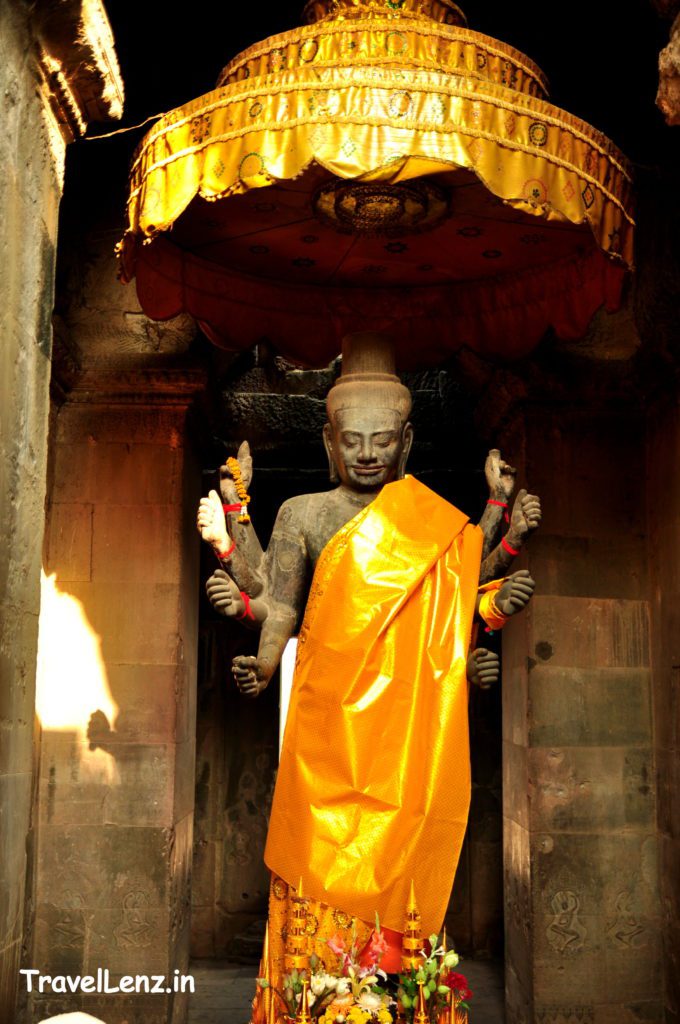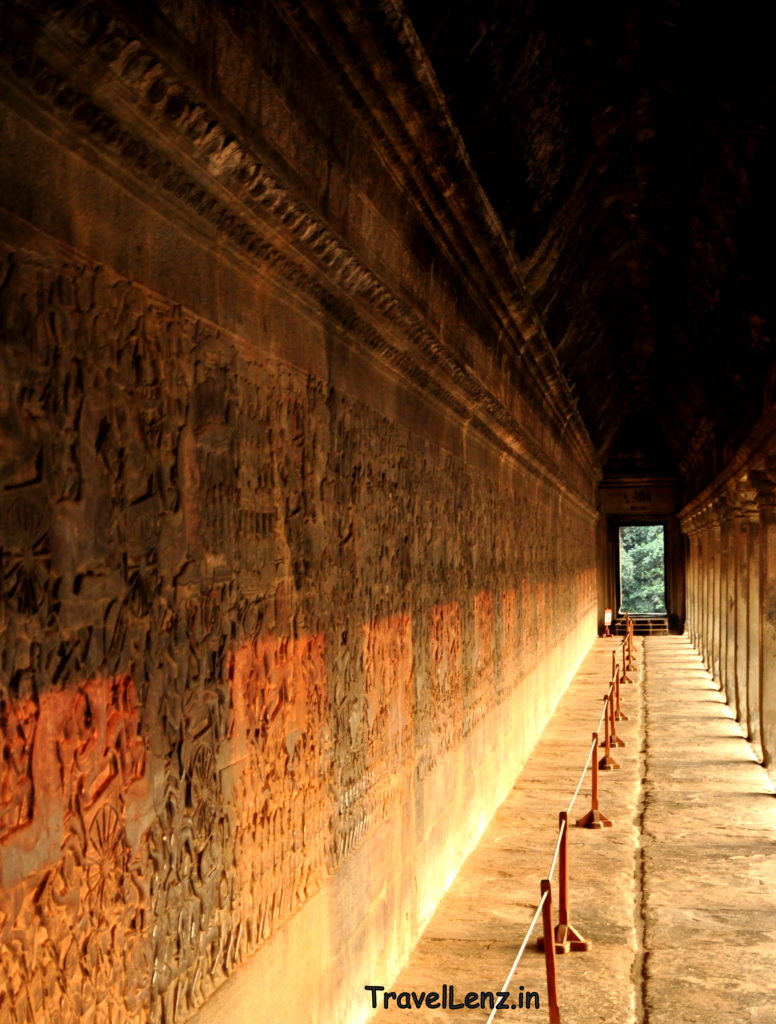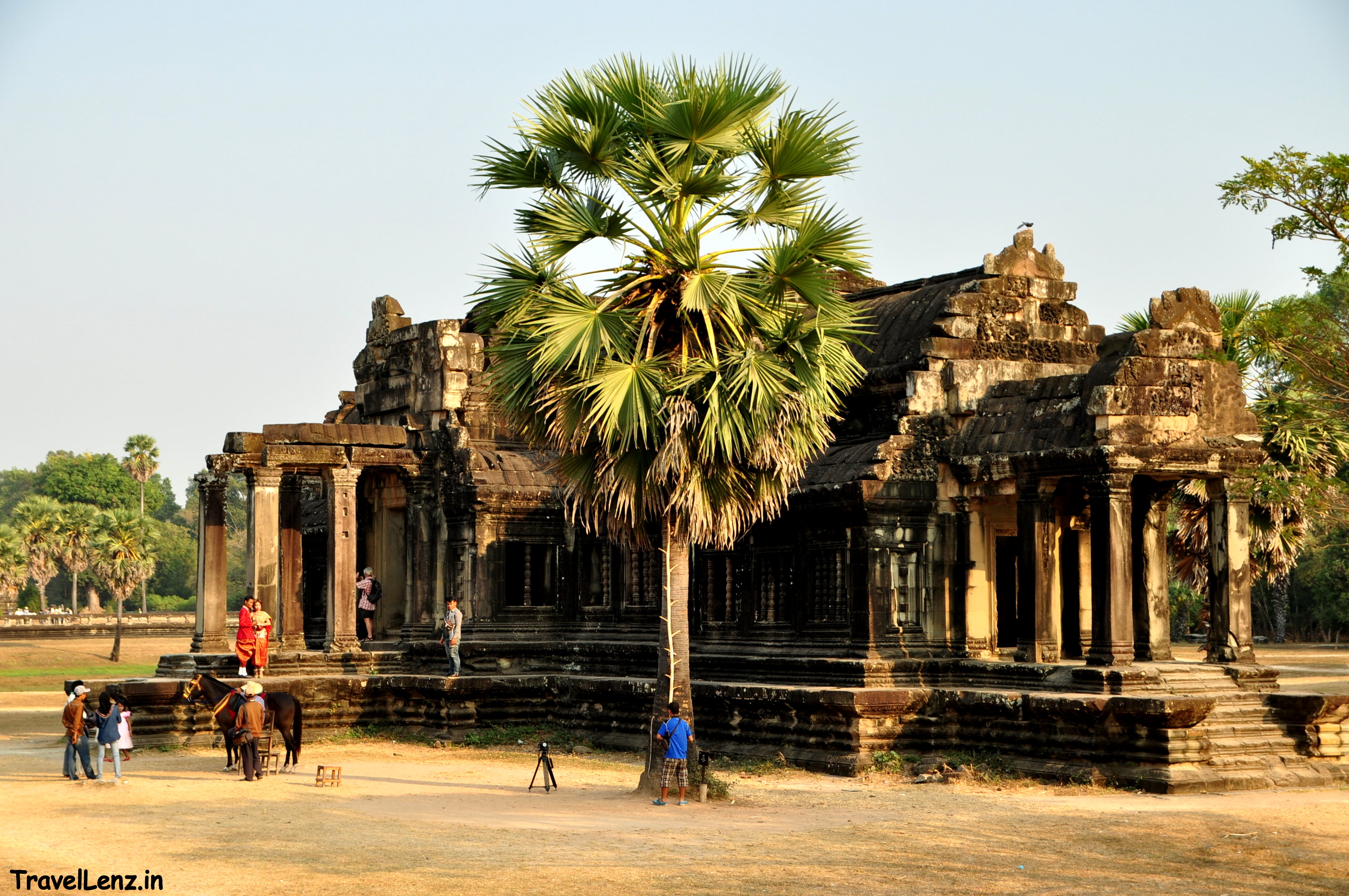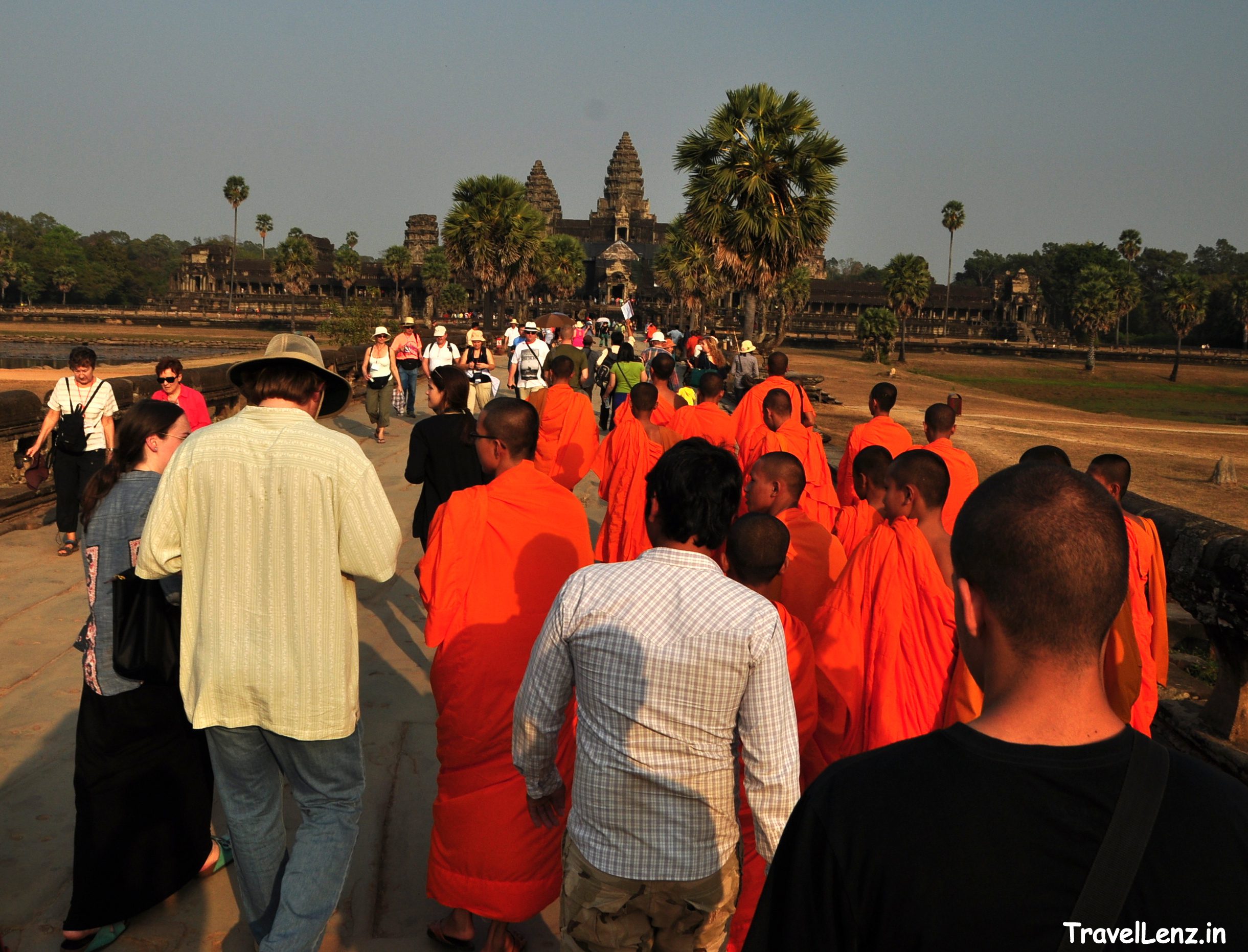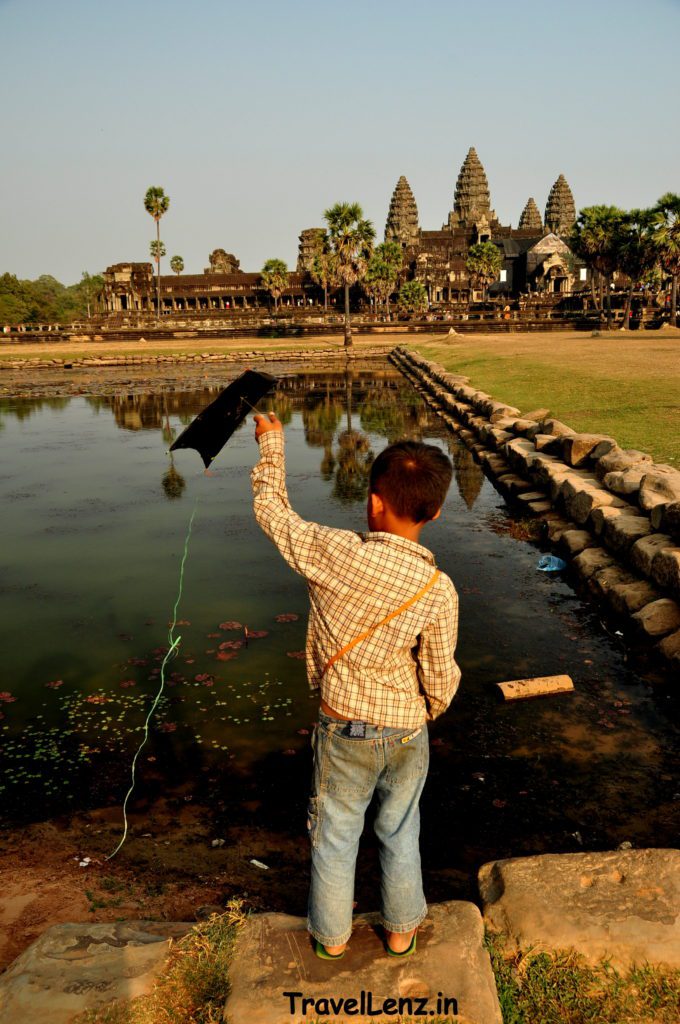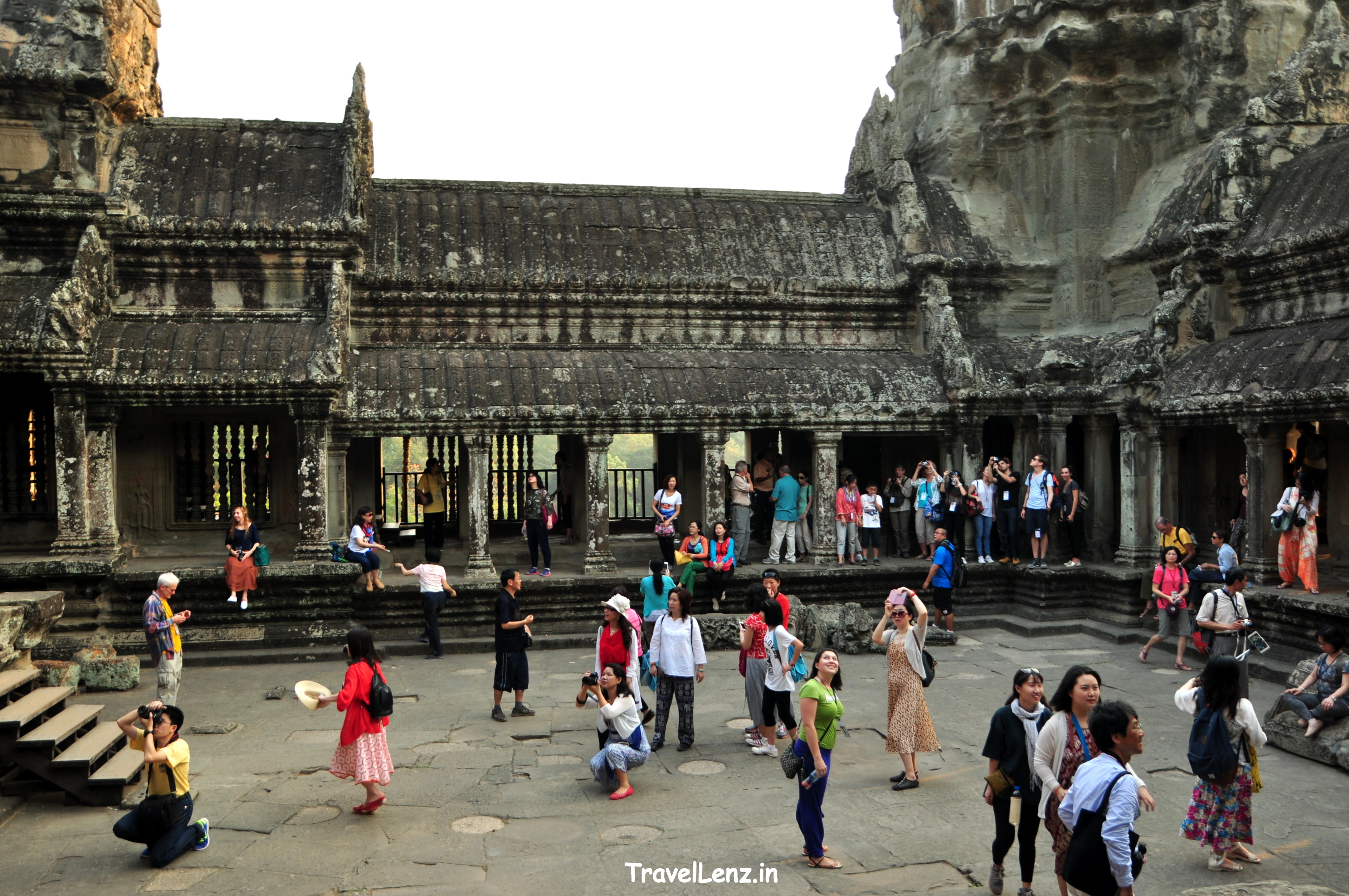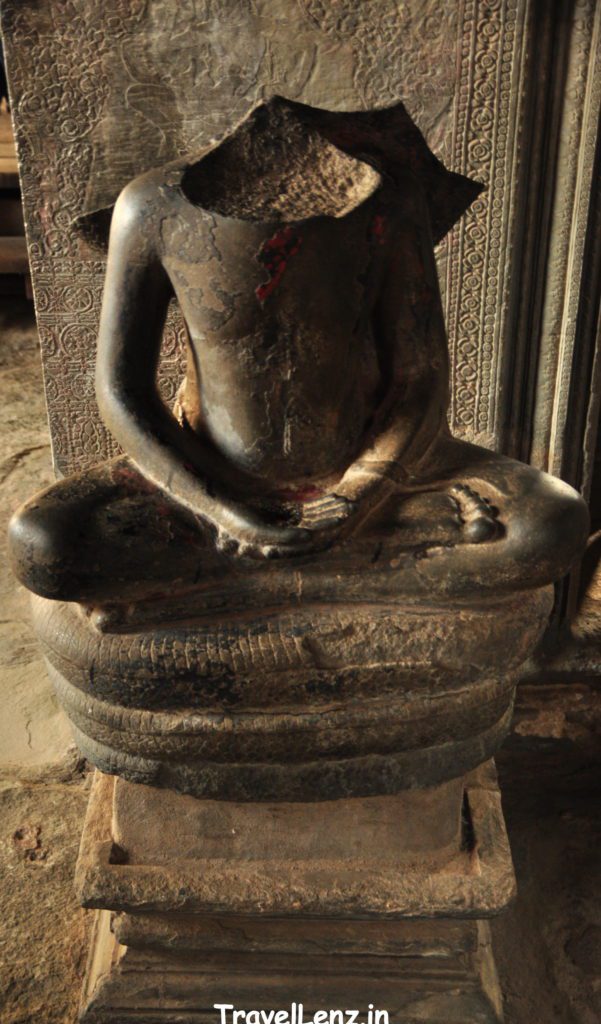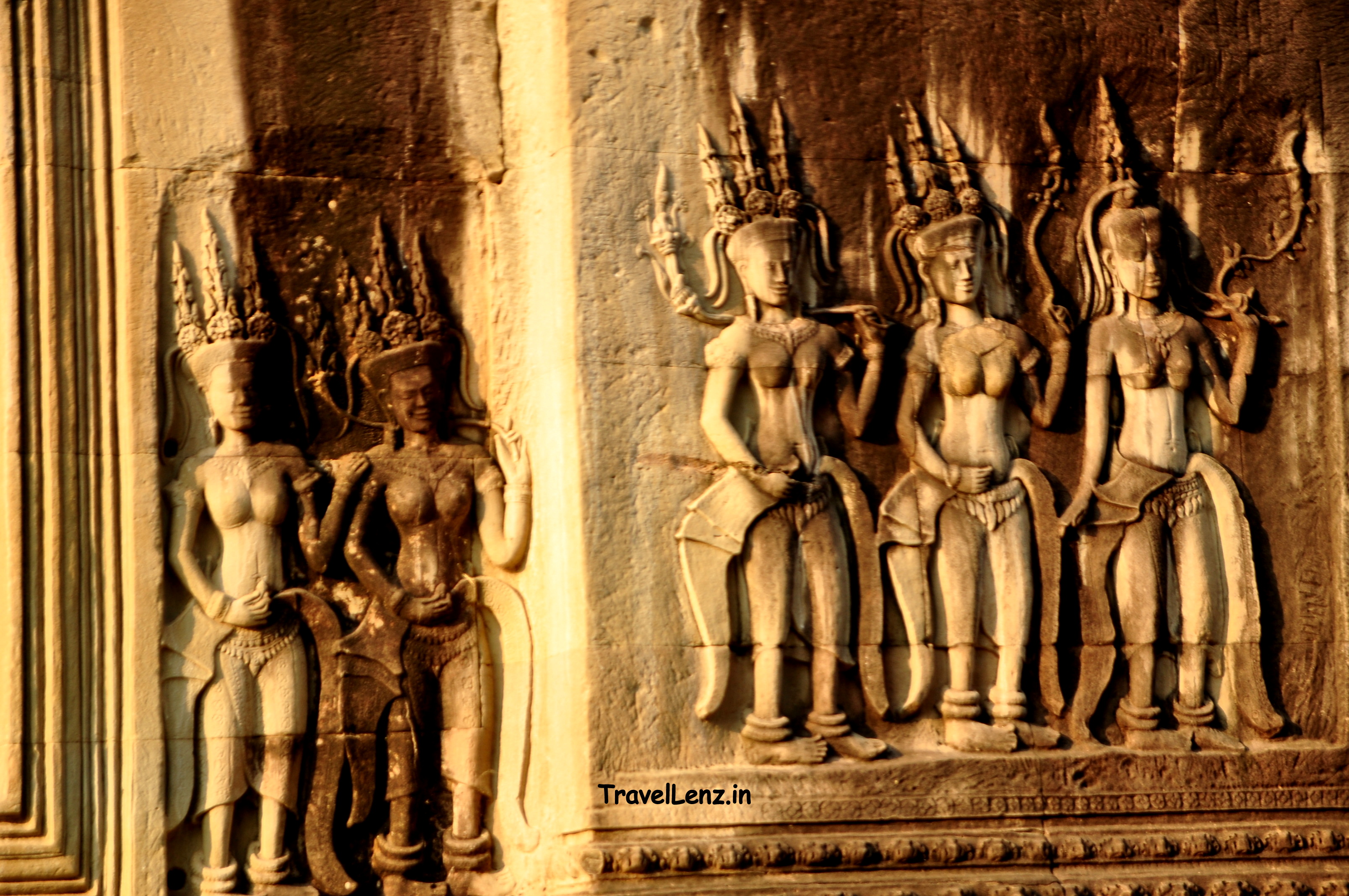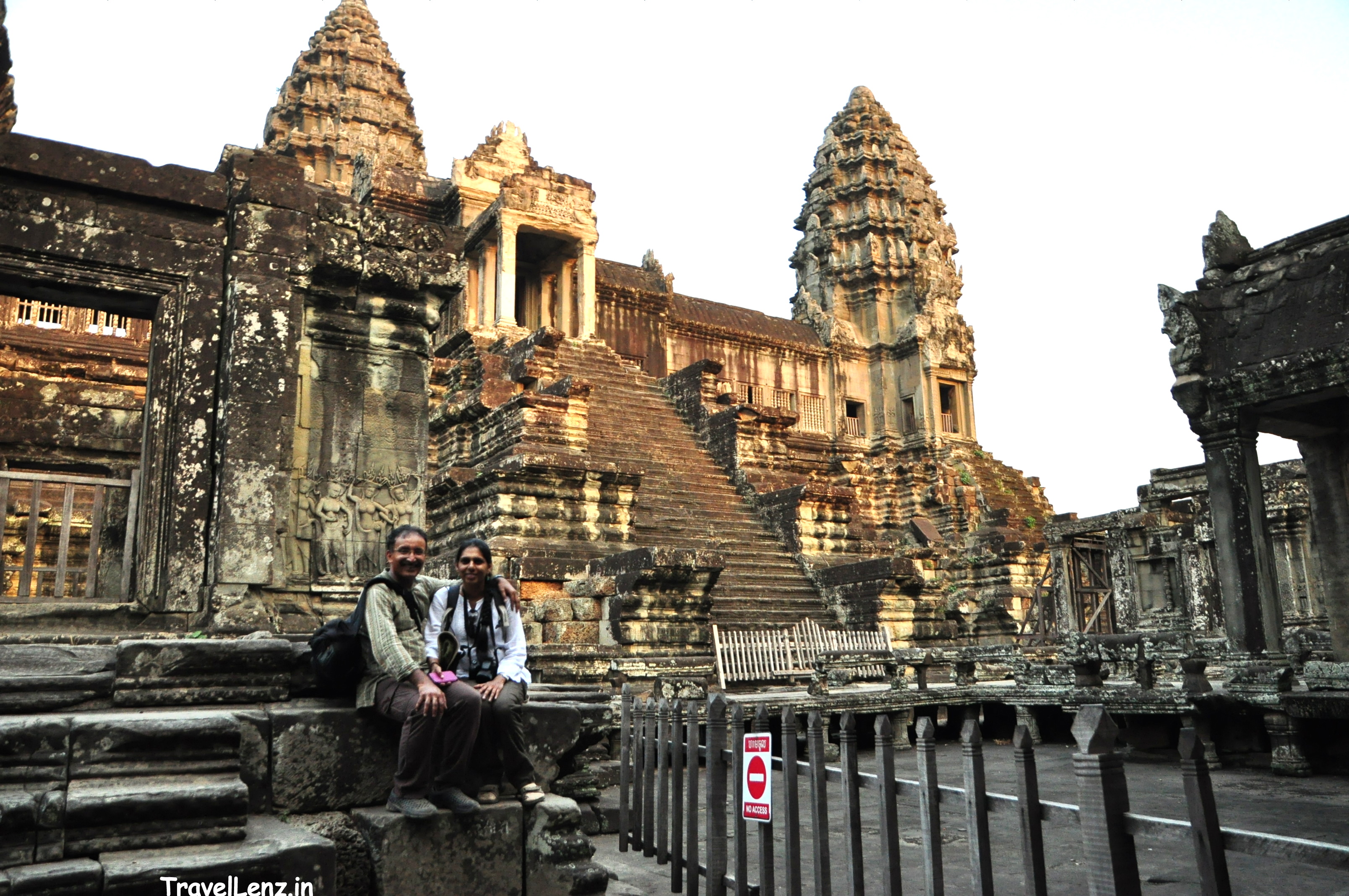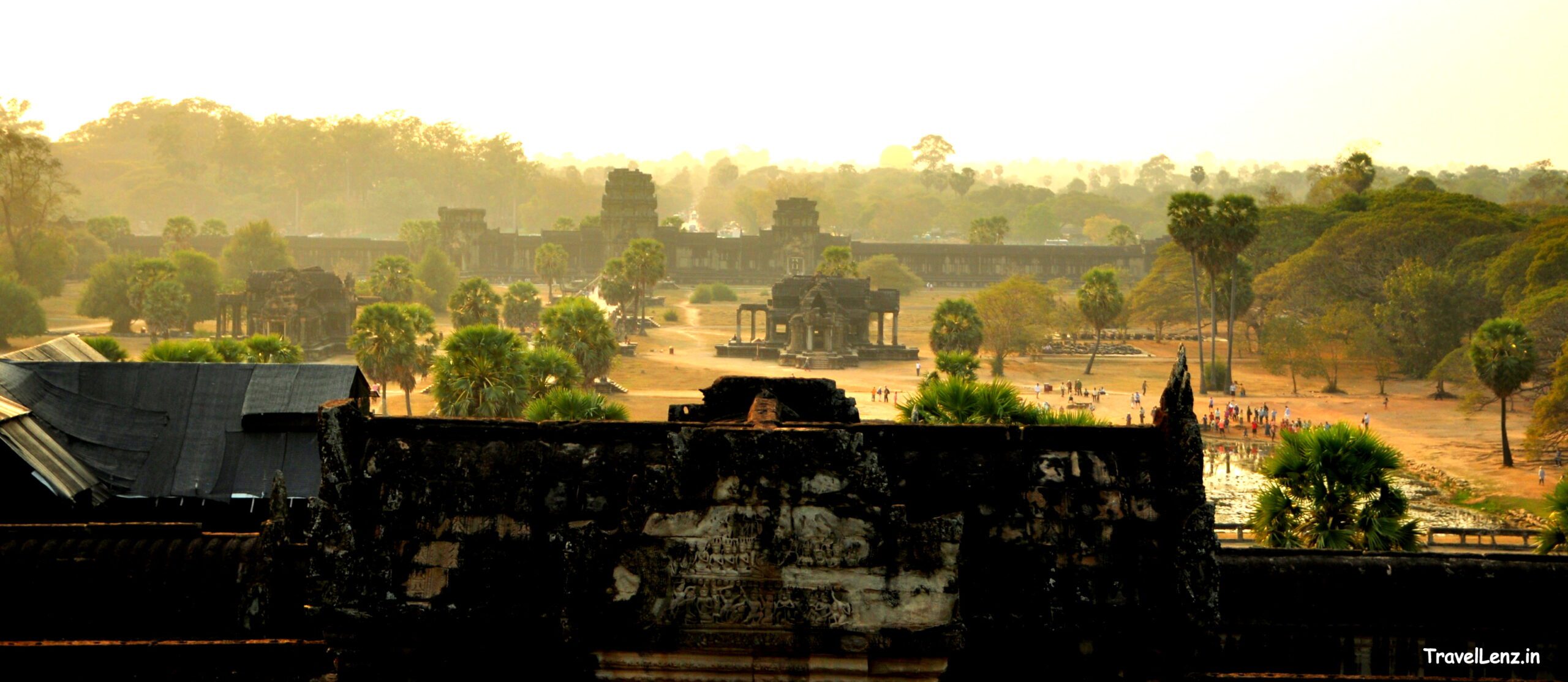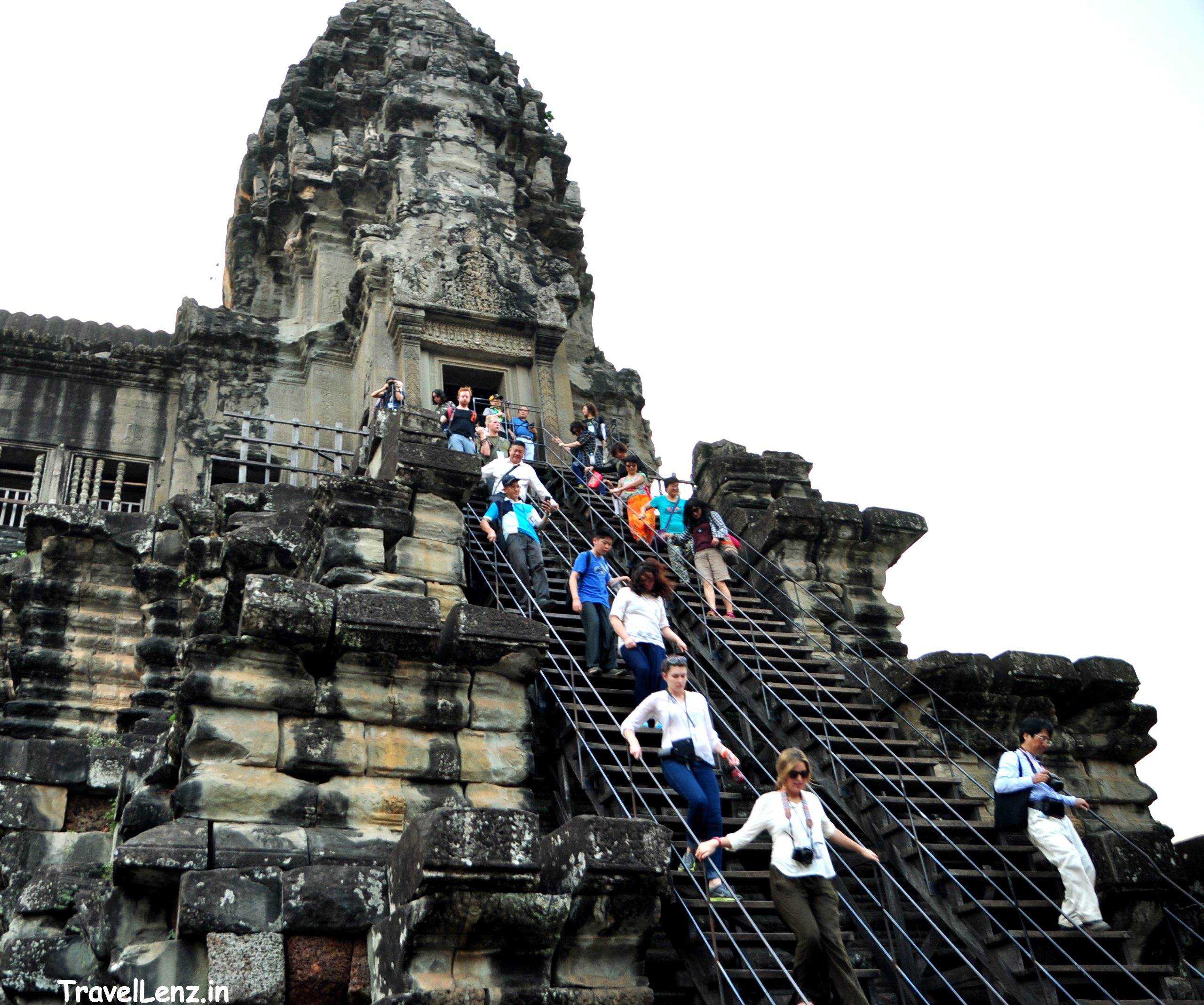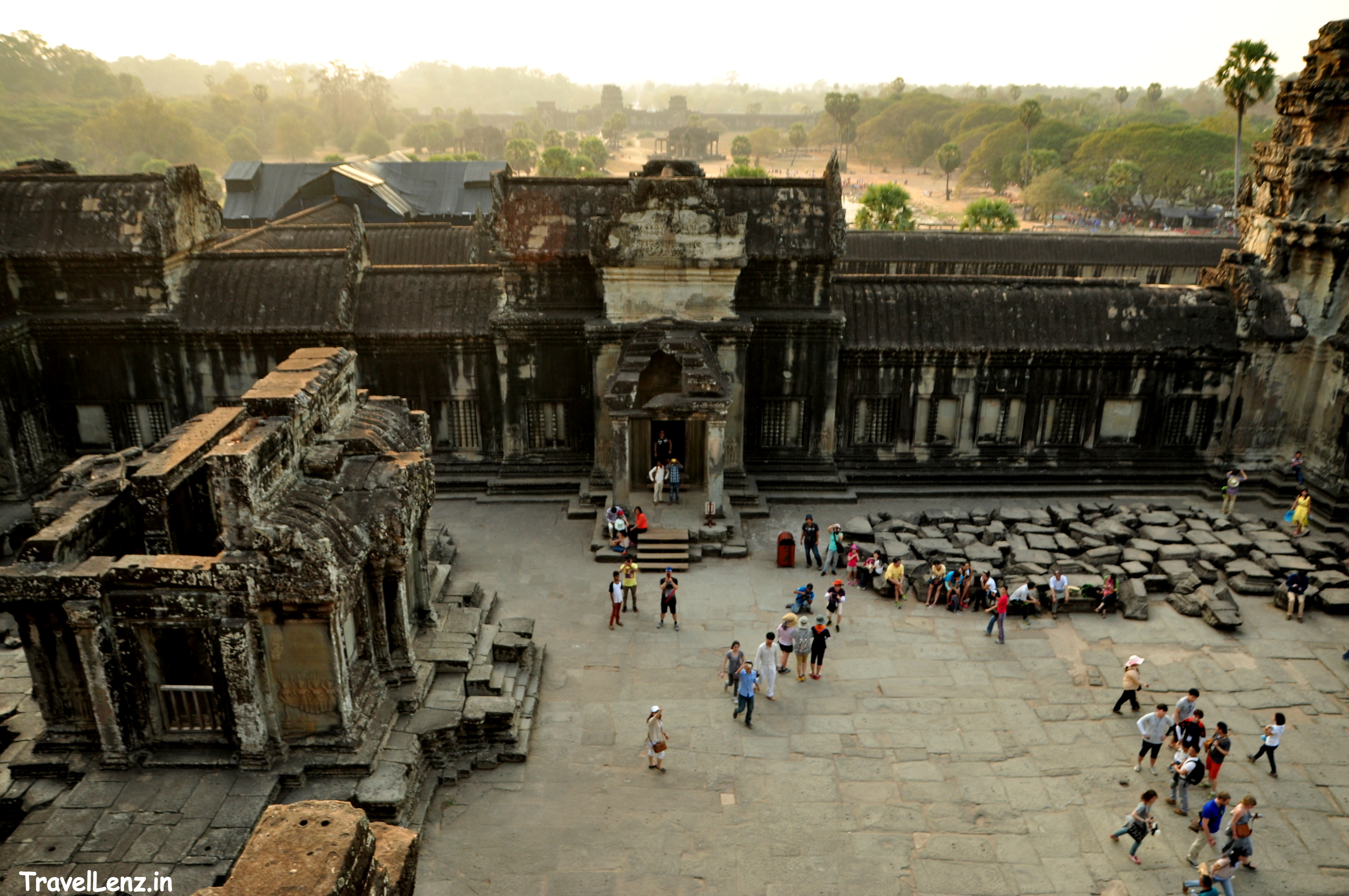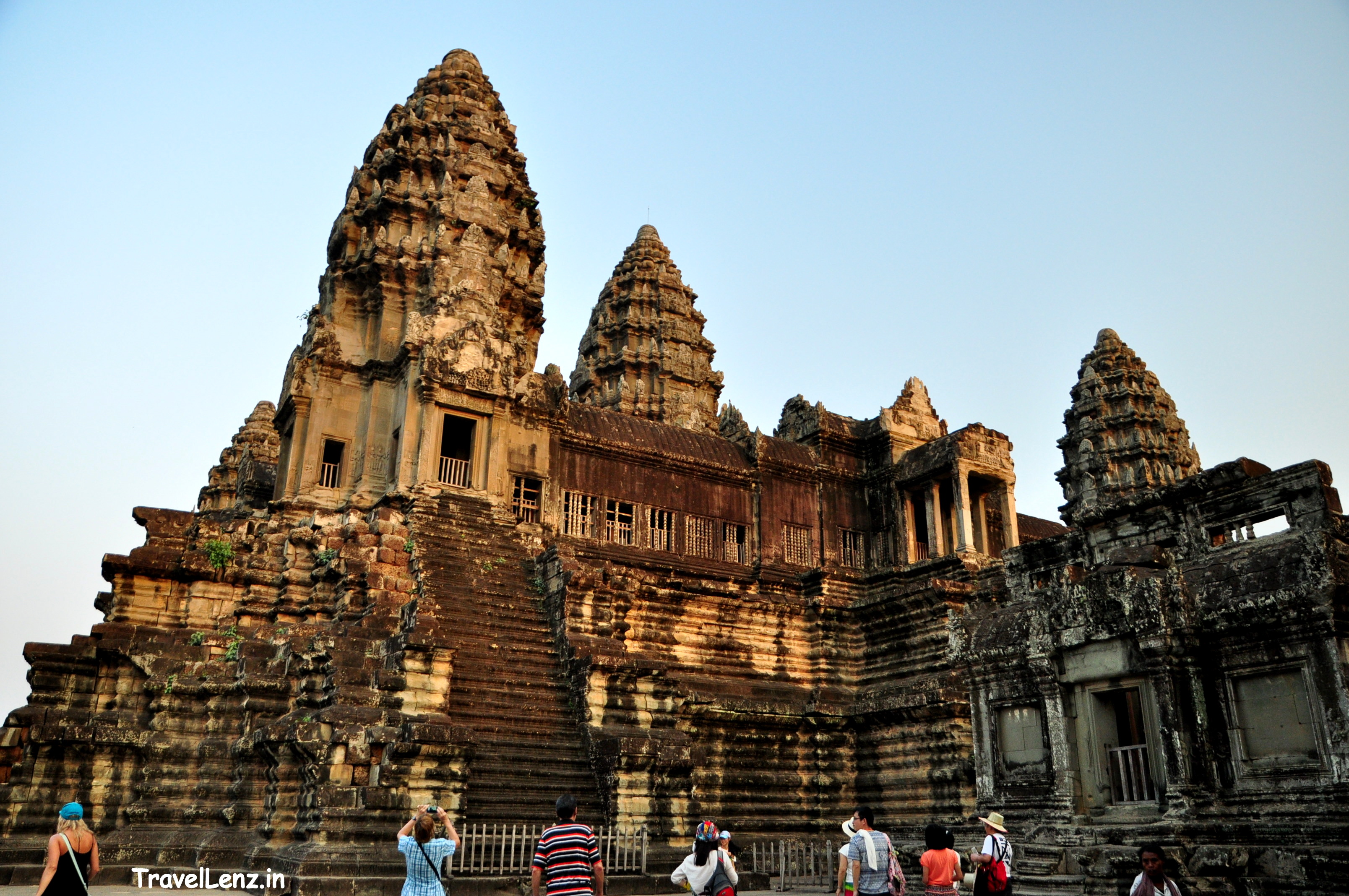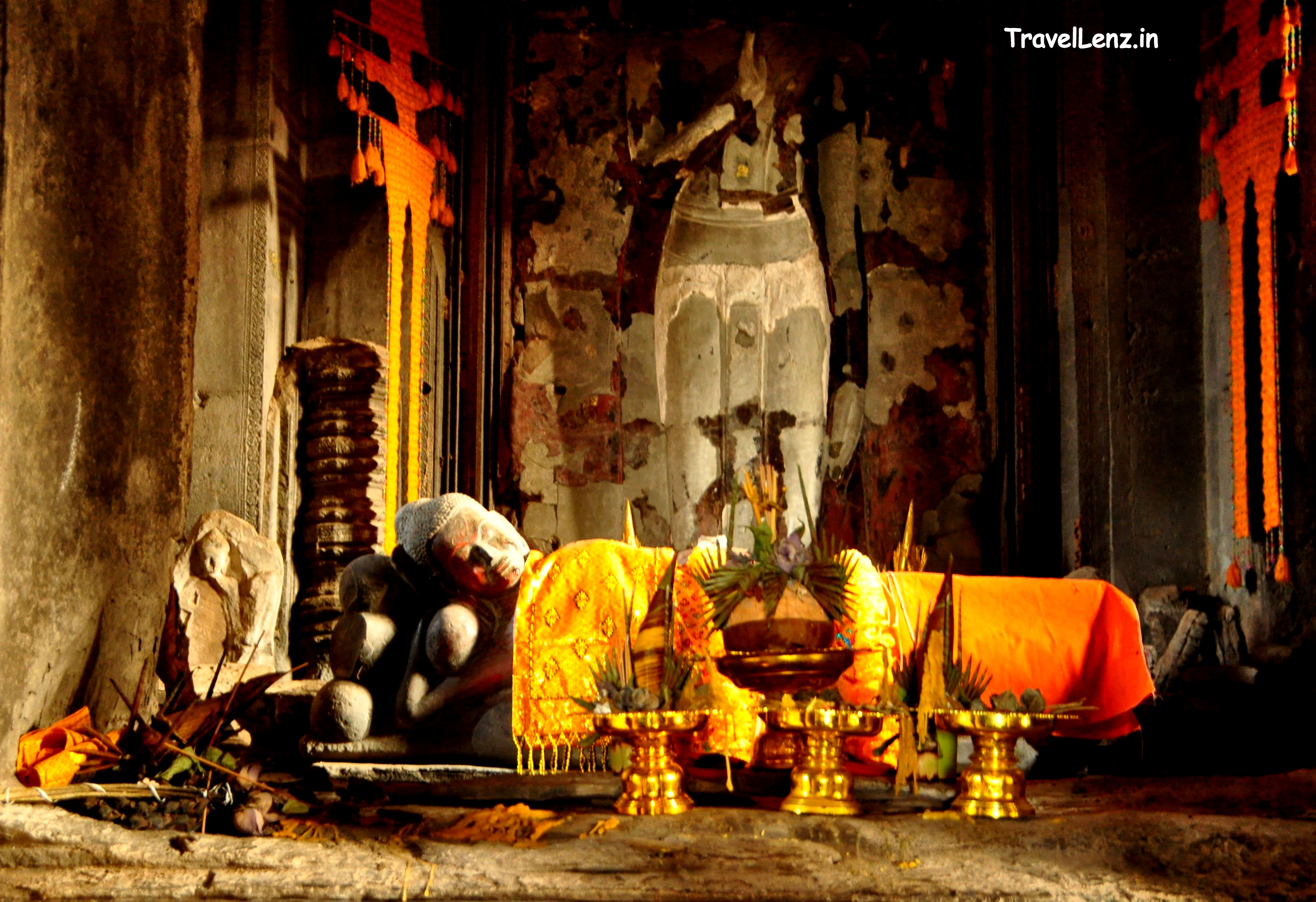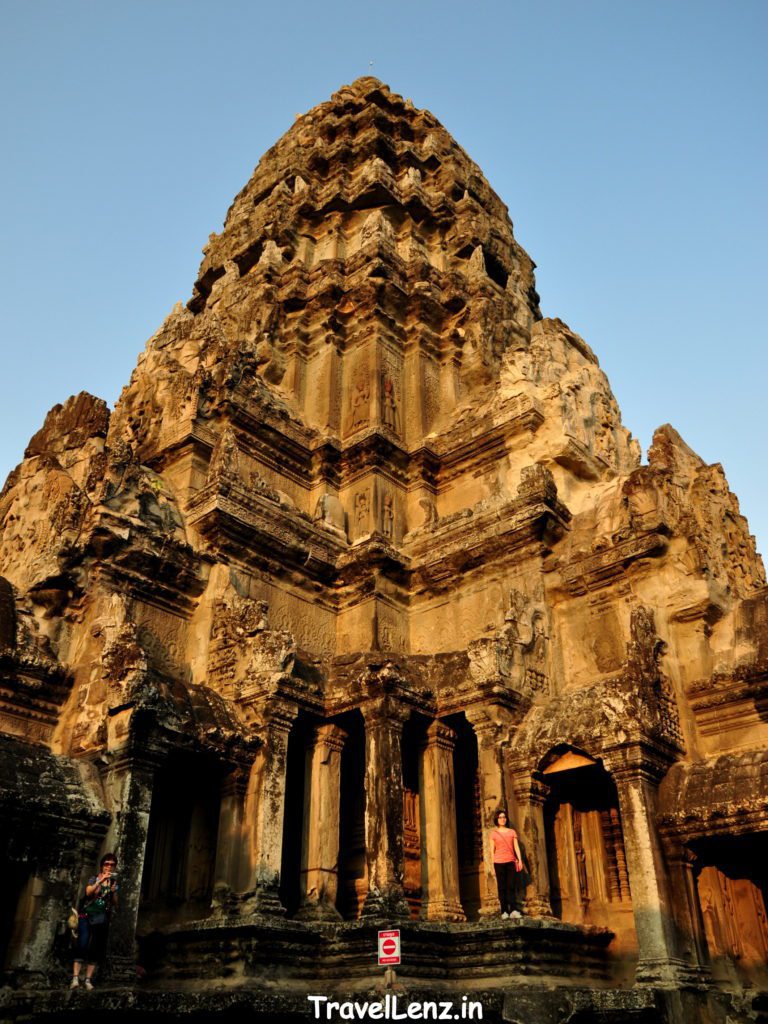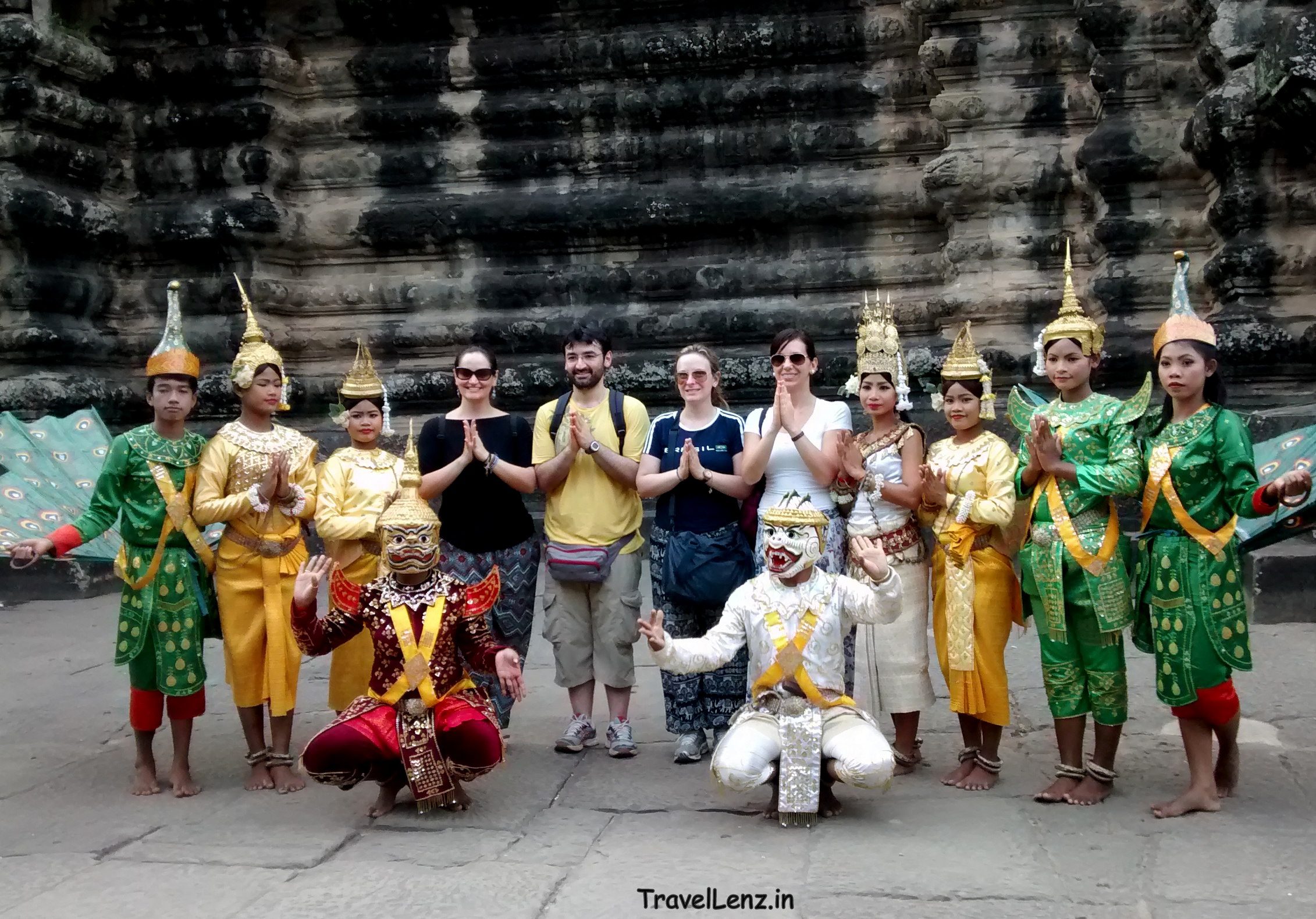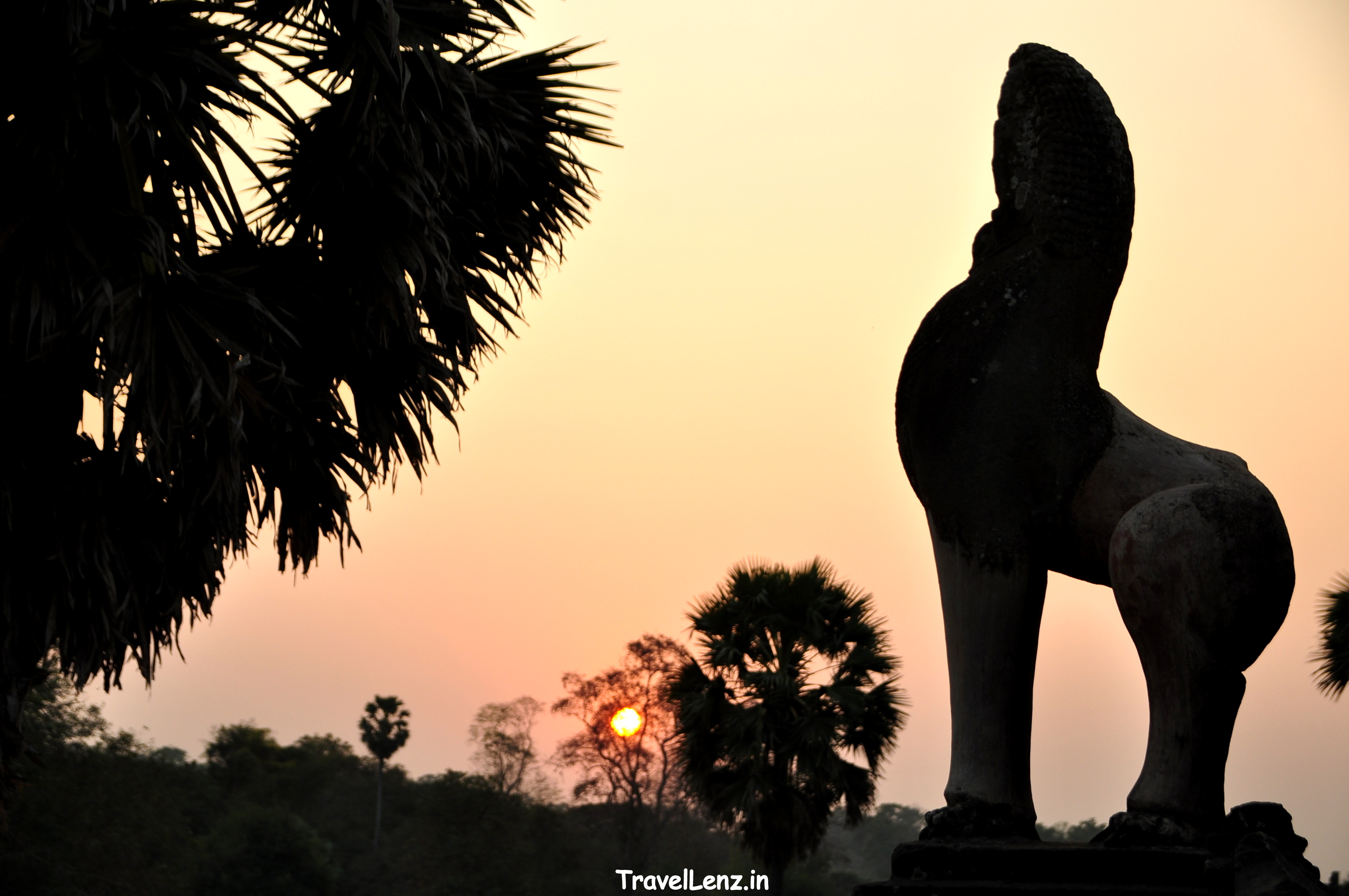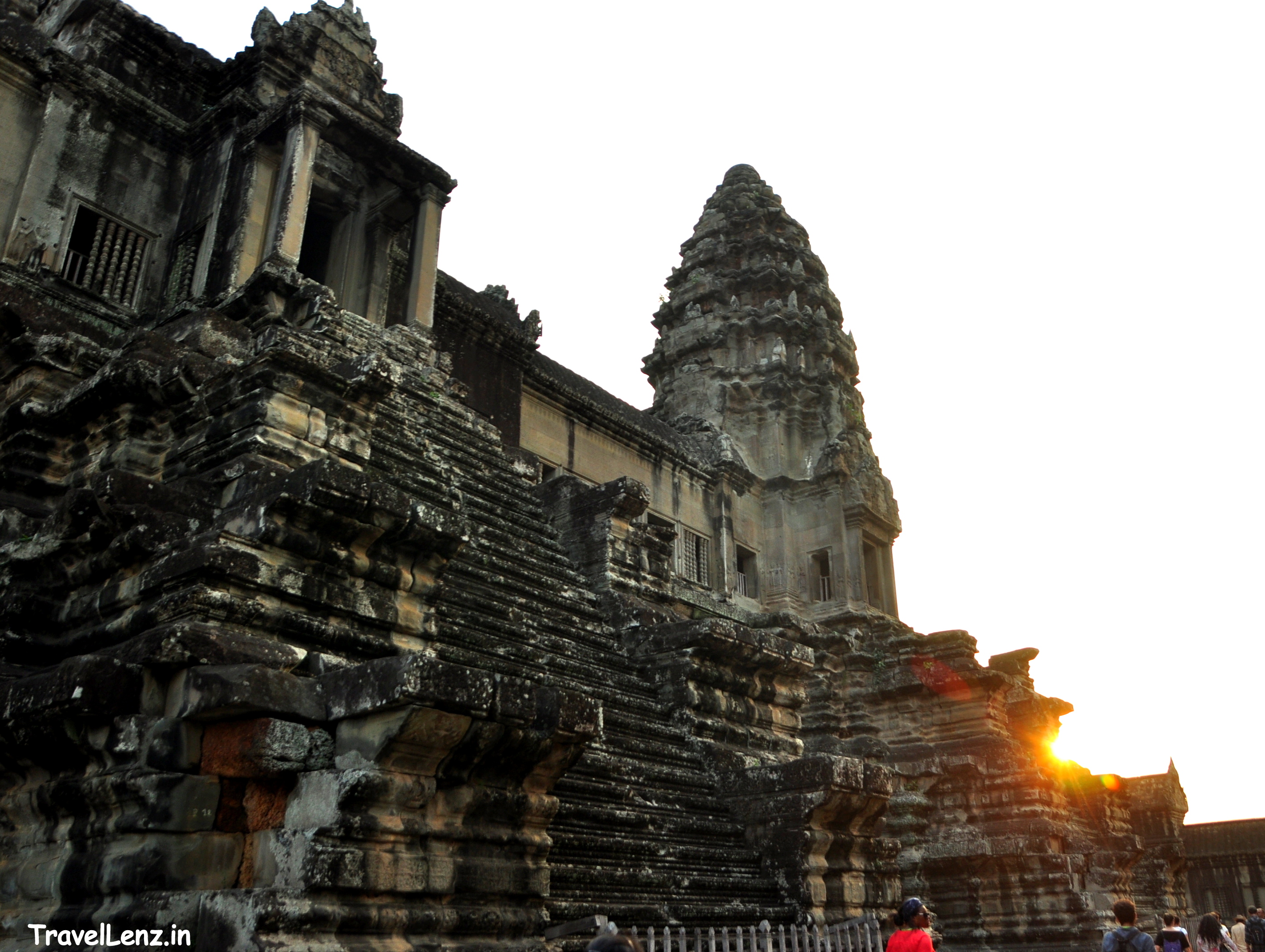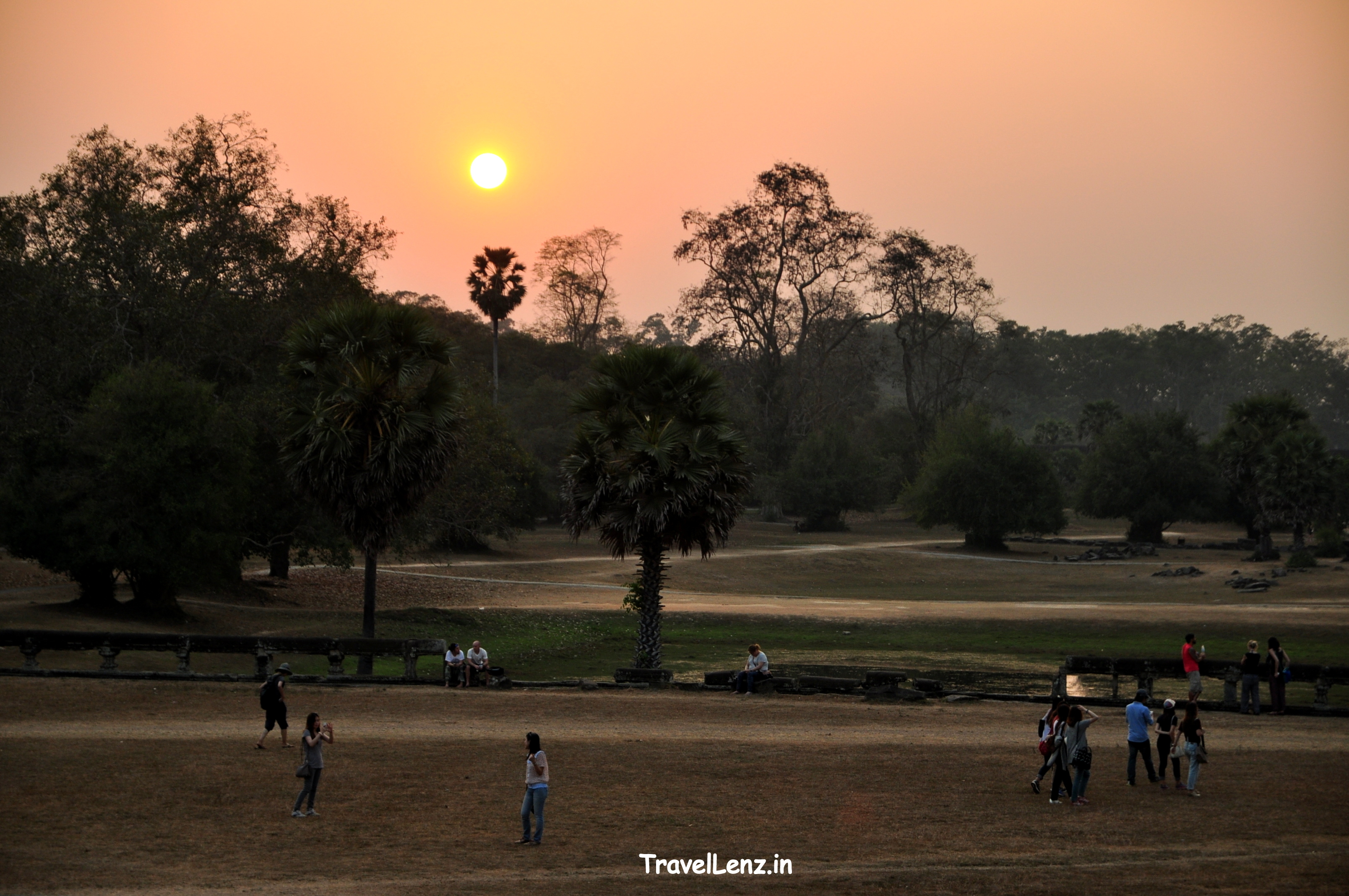Last Updated on May 21, 2021
Our next stop was Angkor Wat – Cambodia’s famous UNESCO World Heritage Site and the largest religious monument in the world. By this time, we were hot and sweaty, but were we ready to give up and call it a day? Nah!! We were to spend the few evening hours before sunset, exploring Angkor Wat. Tes had also promised us the next day’s sunrise over Angkor Wat and a more detailed exploration of the bas-reliefs.
“Where are the words to praise a work of art that may not have its equal anywhere on the globe?” wrote French naturalist-explorer Henri Mouhot, who stumbled upon the nearly forgotten Angkor Wat in 1861.
Ankgor Wat, with its incredible waterside setting, has got a mythical feeling about it. We had seen the classic view of Angkor Wat from the bank of the surrounding moat a hundred times on the numerous blogs and travel write-ups that we had scoured the internet for information. But nothing approaches the actual experience of seeing this temple.
Angkor Wat – a few fats
The whole complex is set within a broad moat, a little less than 200 m in width; the whole complex itself has a total area of 200 hectares. To put it more in a kilometre perspective, the area is a rectangle of 1.5 km X 1.3 km. And that’s huge!!!
Like many of the other Khmer temples, Angkor Wat comprises of a pyramid in the centre surrounded by concentric galleries. Angkor Wat has three concentric rectangular galleries, each gallery has entrances (gopuras) and corner towers, not to mention the intricate bas-reliefs found on the gallery walls. There are courtyards found between each gallery which have smaller shrines. The ground is also peppered with ponds with beautiful red lotus flowers and reflections of the temple towers.
At the center are 5 towers in a quincunx arrangement – the middle one is the tallest, said to be as tall as the Notre Dame Cathedral in Paris.
Angkor Wat is not just a series of elevated towers, covered galleries, chambers, porches, and courtyards on different levels linked by stairways. Not to mention the intricacy of the bas-reliefs in the galleries to the symmetry of the apsara motifs to the Naga and Lion balustrades; yes, everything about this ancient temple is mesmerising.
This temple represents a microcosm of the Hindu universe – the moat represents the mythical oceans, the successive galleries represent the mountain ranges and the central tower, the Mount Meru.
Over the moat on the first causeway
It was hot outside, but the sight of the temple’s towers against the clear blue sky in the balmy afternoon Cambodian sky felt like a cool breeze.
And there’s nothing quite like that first view of the Angkor Wat towers, as you begin to walk down the long stone pathway that is built over the moat. Guardian stone lions flank the steps leading to the causeway. The balustrades of the causeway are in the form of naga (serpent) bodies raised on square columns, placed intermittently, and ending in spread out fierce naga heads.
Tourists were already flooding the entrance as we walked over the moat. The artificial moat surrounding the temple provides stability to the structure by keeping constant the humidity of the sandy ground below. From here, surprisingly only four towers were visible
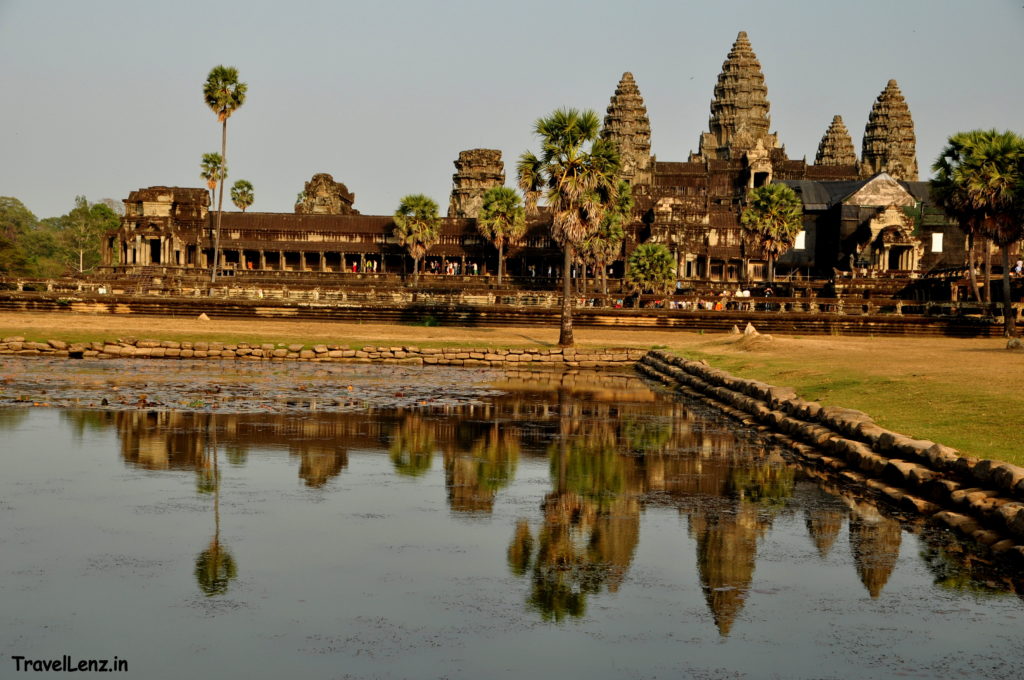
Hinduism and Buddhism
Once we crossed the moat we reached the outer gallery. This western entrance gopura had three towers – the middle one a little larger than the ones on both sides. Instead of taking the bigger central entrance, we walked towards the right and climbed up the steps to reach a shrine which housed a huge eight-armed Vishnu statue with the head replaced by that of Buddha.
Angkor Wat was a Hindu temple dedicated to Vishnu and built by the Khmer king Suryavarman II in the first half of the 12th century. Tes explained why this eight-armed statue of Vishnu was dislodged from the central shrine and now lay in one of the outer galleries.
When Buddhism became the predominant religion towards the end of the 12th century, many Hindu shrines were transformed into Buddhist ones and Hindu Gods and Shivalingas were removed from the main shrines. At least this statue had a head and all the eight limbs were intact. We found a few unlucky ones – beheaded, limbless or without a nose lying in the many nooks and corners of the complex.
Pallavas contributed the cult of Ashtabhuja Vishnu (eight-armed Vishnu) to Cambodia and it is said that this statue is identical to the one in Ashtabhuja Perumal temple of Kanchi.
There were a lot of local Cambodians and other tourists, mostly Japanese and Thais, worshipping the idol, bowing and crouching in front, lighting incense sticks and placing flowers. We too joined them in prayers, eyes closed and palms joined until we were jolted out of our trance by a comment, “This Nataraja looks so beautiful!!”.
We did not want to enlighten whoever commented that and continued our prayers. With a never-ending list of Hindu gods, goddesses, their incarnations and their children, there is enough confusion for followers of other faiths. But for us, the Khmer temples had already forged a special bond. We felt that it was our own history, faith and beliefs that were reflected on the walls, bass reliefs, sculptures, and shrines.
Pol Pot’s savagery
Tes mentioned that many sculptures and statues were torn from the temple walls and sold on the black market to raise money for Pol Pot’s draconian schemes.
In a stone pillar just to the right of the western gate lay remnants of a war zone – bullet holes. Pol Pot’s men had also carried out target practice in these sacred spaces!!!
We returned back to the central tower and entered a gallery. Along the corridors of the outer gallery lay the famous bas-reliefs, each telling an epic story from Mahabharata and Ramayana – some about victories, some about deaths, some about invasions, about processions, pageantry, elephants, gods, demons, heaven and hell. We were to wait till the next day to get a glimpse of all of it.
The libraries and ponds
From here we walked on to another causeway, this one was not over water but over a grass field. Here, again the walkway was bordered by a series of carved nagas and guardian lions. Two stone libraries, in varying states of disrepair, were found on the ground.
There was a couple of newlyweds in their bridal finery posing against this picturesque backdrop for professional photographers.
As we walked along the pathway, we came across a few monks in their colourful orange robes. They provided a striking contrast against the grey sandstone of Angkor Wat.
From here the towers looked commanding – four smaller ones around a soaring bigger central tower. One thing was clear about this complex – Angkor Wat’s greatness hits you in stages. And we had not seen the best part yet.
On either side of the causeway, there were two ponds that caught the beautiful reflections of Angkor Wat. Hundreds of pink lotus flowers bloom from the months April to October. Besides being simply beautiful, the flowers also have a special meaning for local people and are considered as sacred and symbolise enlightenment and purity.
Entering Angkor Wat
We were now standing in front of the entrance gopura of the temple itself. There were another set of galleries that extended onto both sides. We climbed up the steps to enter a structure called the cruciform cloister. There were four rectangular stone basins, perhaps made to contain water at a time. This cloister also connected the first and second levels. The symmetry of this cloister was perfect.
There used to be a row of thousand Buddha statues here giving it the name “The hall of thousand Buddhas”. The statues were either destroyed – headless and limbless – and the rest removed for safety.
Every space of the walls was adorned with something carved – gods and goddesses, demons and kings, not to mention the apsaras. When you see the enchanting dancing maidens with enigmatic smiles and with varied depictions of jewelry, clothing, floral decorations, hairstyles and hair gears you get a feeling that the sculptures were modeled on real apsaras in the Khmer court.
There were few quirky facts about the temple as in all the ancient ruins that only a guide will show you – like the acoustics of the hall of echoes. Thump your chest standing inside it and it sounds as loud as a drum. Tes’s explanation – if you truly pray with your heart it reaches the divine.
Climbing up to the central tower
As we climbed up to the third and final level – it felt as if we were doing the final ascent of Mt. Meru. The central tower rises 213 feet above the ground – and it looked taller, probably due to the pyramid arrangement.
The ascent up the narrow steps to the base of the central tower was scary. The angle of the stairs and the proportions of the central tower added to the adrenalin. There were four stairways up, on four sides, and just one, the southern stairway, had a railing installed to assist the nervous.
From the top of the steps, the view was commanding – we could see all the way to the western entrance, where we came through, the libraries, the causeway, the ponds and the galleries.
Bakan – the principal sanctuary
The principal sanctuary is called the ‘Bakan’ and was originally opened on all sides. It also housed the Vishnu statue – the eight-armed one that we had seen at the outer gallery.
When the temple was converted to a Buddhist temple, the principal shrine doors were blocked by walls carved with standing Buddha statues. Now only the southern side is open, and a reclining Buddha is found at the altar.
Just like many of the temples back home in India the inner sanctums of most of these shrines are small. The probable reason being only the attending priests entered the temple’s inner sanctum and worshippers would gather outside for prayers and rituals.
Had the apsaras on the walls come to life? We came across an Apsara Group dressed up in traditional Khmer costumes who were encouraging tourists to pose with them in different apsara poses….of course for a fee!!
And the sunset
Finally, the icing on the cake – the sunset at Angkor Wat. The sun doesn’t set over Angkor Wat, it sets on the other side, but you do get to see the whole temple complex glisten in a beautiful golden hue. The light falls over the temples making the sculptures all the more mysterious and glowing.
The park actually has an Angkor sunset finder to help you find that perfect spot.
And the best part – there are not many people who choose to stay and wait for the sunset making it less crowded than the mornings. It was a peaceful feeling, a perfect setting to enjoy the beauty of the temple without any distraction.
Tomorrow we had plans to watch the sunrise over Angkor Wat and explore the bas-reliefs carved on the gallery walls in more detail.


